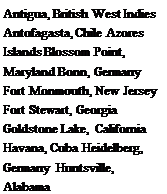Explorer IV operation
With the failure of the Explorer V launch and the NOTSNIK attempts, the Argus Project was left with only Explorer IV to obtain the crucial orbital data coverage. Fortunately, the satellite operated perfectly for nearly two months, from 26 July until 21 September, well after the Argus detonations.
 |
 |
It was important to obtain data from the full range of latitudes covered by the satellite for both an expanded study of the naturally occurring radiation, and for detecting and measuring the Argus Effects. The full suite of Minitrack stations established earlier as part of the Vanguard program was used. Additional stations were set up to extend the orbital coverage and, most important, to provide coverage at the higher latitudes. The full suite of stations used for Explorer IV data reception was impressive:
The initial month’s data from Explorer IV established the natural conditions in the Earth’s radiation trapping region and showed rather small responses to the lower- altitude Teak and Orange bursts on 1 and 12 August. When the first Argus nuclear device was detonated on 27 August, the satellite easily and promptly detected the
OPENING SPACE RESEARCH
 resulting particle shell and did likewise for the two bursts that followed on 30 August and 6 September.
resulting particle shell and did likewise for the two bursts that followed on 30 August and 6 September.
On 24 August 1958, the day after the Explorer V attempt, I was feeling completely worn out and swamped by the work ahead. Work was progressing on PL-16 (the precursor to Explorer 7); planning for a number of lunar probes was heating up; and I was heavily involved in the Explorer I, III, and IV data reduction. Additional missions were being discussed. On top of that, Van Allen was on vacation on Long Island, so I had only infrequent telephone contact with him to resolve issues. A new academic semester was about to start. I had not been taking courses for most of the year and was very concerned about completing the work for my master’s and Ph. D. degrees. On that day, I expressed some of those concerns by writing in my journal:
The future is confusing, and a big question mark. At least four projects can be seen in the near future, with no sign of a letup. This in view of the fact that I planned to return to school this fall. I can hardly bear to think of not obtaining my Ph. D., yet, how can I escape from this other work. My family is another consideration. I have been away from them so much the past year, … I cannot continue to spend one hour per day or less with my family and expect to have a livable home relationship and happy, well-adjusted children.17
That difficulty was resolved to a satisfactory degree at the end of the month. By then, Van Allen had returned to the campus and he, Carl McIlwain, and I were able to sit down for an extended discussion of the laboratory’s space-related work. At that meeting, I stated that I would be unable to continue the combination of the heavy instrument development and management load that I had been carrying, plus the work on the data and an academic load. We agreed to limit our total laboratory efforts to three major project series and to split them up among us. I would continue with the Explorer activities, Carl would take the Space Technology Laboratories’ lunar shots (Atlas-Able and Pioneers 1 and 2), and Van Allen would take the JPL lunar shots (Pioneers 3 and 4).18
I promptly signed up for courses in Classical Theoretical Physics and Nuclear Physics.










